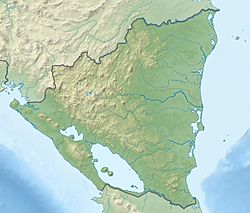Lake Apanás facts for kids
Quick facts for kids Lake Apanás |
|
|---|---|
 |
|
| Location | Jinotega, Nicaragua |
| Coordinates | 13°11′40″N 85°58′35″W / 13.1944957°N 85.9764282°W |
| Type | reservoir |
| Primary inflows | Tuma River |
| Primary outflows | Tuma River |
| Basin countries | Nicaragua |
| Surface area | 45.90 km2 (17.72 sq mi) |
| Official name: Lago de Apanás-Asturias | |
| Designated: | 8 November 2001 |
| Reference #: | 1137 |
Lake Apanás is a large, man-made lake in northern Nicaragua. It is known as a reservoir because it was created by building a dam. This important lake helps produce a lot of electricity for the country. It is located in the Jinotega department, which is in the northern part of Nicaragua.
Contents
Lake Apanás: Nicaragua's Power Lake
Lake Apanás is a very important body of water for Nicaragua. It was formed when the Mancotal Dam was built on the Tuma River. This happened north of the city of Jinotega. The lake covers a large area, about 45.90 square kilometers. That's like having many football fields put together!
What is a Reservoir?
A reservoir is like a giant, artificial lake. People create reservoirs by building a dam across a river. The dam holds back the water, forming a large pool. Reservoirs are built for many reasons. They can store water for drinking, for farming, or to control floods. Lake Apanás was built mainly to create electricity.
How Lake Apanás Makes Electricity
Lake Apanás plays a key role in providing electricity to Nicaragua. The water stored in the lake is used to power the Centro América Power Plant. This plant uses a special type of energy called hydropower.
Understanding Hydropower
Hydropower is a clean and renewable way to make electricity. Here's how it works at Lake Apanás:
- Water from the lake flows through large pipes called penstocks.
- This fast-moving water spins giant turbines, which are like big propellers.
- The spinning turbines are connected to generators.
- Generators turn the movement into electricity.
- This electricity then travels through power lines to homes and businesses across Nicaragua.
A Special Place for Nature
Lake Apanás is not just important for power. It is also recognized as a special place for nature. On November 8, 2001, it was named a Ramsar site.
What is a Ramsar Site?
A Ramsar site is a wetland area that is important for nature around the world. These sites are recognized under an international agreement called the Ramsar Convention. This means Lake Apanás-Asturias (which includes the lake and surrounding areas) is protected because it is home to many different plants and animals, especially birds. Protecting these areas helps keep our planet healthy.
See also
- In Spanish: Lago Apanás para niños


